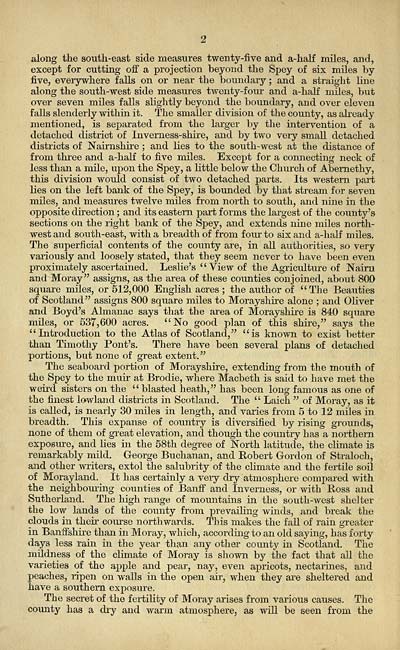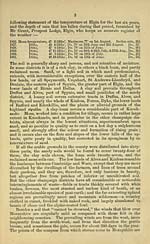Counties > Moray (Elgin) and Nairn Shires > 1863 - Black's Morayshire directory, including the upper district of Banffshire
(14)
Download files
Complete book:
Individual page:
Thumbnail gallery: Grid view | List view

along the south-east side measures twenty-five and a-half miles, and,
except for cutting off a projection beyond the Spey of six miles by
five, everywhere falls on or near the boundary ; and a straight line
along the south-west side measures twenty-four and a-half miles, but
over seven miles falls slightly beyond the boundary, and over eleven
falls slenderly within it. The smaller division of the county, as already
mentioned, is separated from the larger by the intervention of a
detached district of Inverness-shire, and by two very small detached
districts of Nairnshire ; and lies to the south-west at the distance of
from three and a-half to five miles. Except for a connecting neck of
less than a mile, upon the Spey, a little below the Church of Abernethy,
this division would consist of two detached parts. Its western part
lies on the left bank of the Spey, is bounded by that stream for seven
miles, and measures twelve miles from north to south, and nine in the
opposite direction ; and its eastern part forms the largest of the county's
sections on the right bank of the Spey, and extends nine miles north-
west and south-east, with a breadth of from f our to six and a-half miles.
The superficial contents of the county are, in all authorities, so very
variously and loosely stated, that they seem never to have been even
proximately ascertained. Leslie's "View of the Agriculture of Nairn
and Moray" assigns, as the area of these counties conjoined, about 800
square miles, or 512,000 English acres ; the author of "The Beauties
of Scotland" assigns 800 square miles to Morayshire alone ; and Oliver
and Boyd's Almanac says that the area of Morayshire is 840 square
miles, or 537,600 acres. "No good plan of this shire," says the
"Introduction to the Atlas of Scotland," "is known to exist better
than Timothy Pont's. There have been several plans of detached
portions, but none of great extent."
The seaboard portion of Morayshire, extending from the mouth of
the Spey to the muir at Brodie, where Macbeth is said to have met the
weird sisters on the " blasted heath," has been long famous as one of
the finest lowland districts in Scotland. The " Laich " of Moray, as it
is called, is nearly 30 miles in length, and varies from 5 to 12 miles in
breadth. This expanse of country is diversified by rising grounds,
none of them of great elevation, and though the country has a northern
exposure, and lies in the 58th degree of North latitude, the climate is
remarkably mild. George Buchanan, and B-obert Gordon of Straloch,
and other writers, extol the salubrity of the climate and the fertile soil
of Morayland. It has certainly a very dry atmosphere compared with
the neighbouring counties of Banff and Inverness, or with. Ross and
Sutherland. The high range of mountains in the south-west shelter
the low lands of the county from prevailing winds, and break the
clouds in their course northwards. This makes the fall of rain greater
in Banffshire than in Moray, which, according to an old saying, has forty
days less rain in the year than any other county in Scotland. The
mildness of the climate of Moray is shown by the fact that all the
varieties of the apple and pear, nay, even apricots, nectarines, and
peaches, ripen on walls in the open air, when they are sheltered and
have a southern exposure.
The secret of the fertility of Moray arises from various causes. The
county has a dry and warm atmosphere, as will be seen from the
except for cutting off a projection beyond the Spey of six miles by
five, everywhere falls on or near the boundary ; and a straight line
along the south-west side measures twenty-four and a-half miles, but
over seven miles falls slightly beyond the boundary, and over eleven
falls slenderly within it. The smaller division of the county, as already
mentioned, is separated from the larger by the intervention of a
detached district of Inverness-shire, and by two very small detached
districts of Nairnshire ; and lies to the south-west at the distance of
from three and a-half to five miles. Except for a connecting neck of
less than a mile, upon the Spey, a little below the Church of Abernethy,
this division would consist of two detached parts. Its western part
lies on the left bank of the Spey, is bounded by that stream for seven
miles, and measures twelve miles from north to south, and nine in the
opposite direction ; and its eastern part forms the largest of the county's
sections on the right bank of the Spey, and extends nine miles north-
west and south-east, with a breadth of from f our to six and a-half miles.
The superficial contents of the county are, in all authorities, so very
variously and loosely stated, that they seem never to have been even
proximately ascertained. Leslie's "View of the Agriculture of Nairn
and Moray" assigns, as the area of these counties conjoined, about 800
square miles, or 512,000 English acres ; the author of "The Beauties
of Scotland" assigns 800 square miles to Morayshire alone ; and Oliver
and Boyd's Almanac says that the area of Morayshire is 840 square
miles, or 537,600 acres. "No good plan of this shire," says the
"Introduction to the Atlas of Scotland," "is known to exist better
than Timothy Pont's. There have been several plans of detached
portions, but none of great extent."
The seaboard portion of Morayshire, extending from the mouth of
the Spey to the muir at Brodie, where Macbeth is said to have met the
weird sisters on the " blasted heath," has been long famous as one of
the finest lowland districts in Scotland. The " Laich " of Moray, as it
is called, is nearly 30 miles in length, and varies from 5 to 12 miles in
breadth. This expanse of country is diversified by rising grounds,
none of them of great elevation, and though the country has a northern
exposure, and lies in the 58th degree of North latitude, the climate is
remarkably mild. George Buchanan, and B-obert Gordon of Straloch,
and other writers, extol the salubrity of the climate and the fertile soil
of Morayland. It has certainly a very dry atmosphere compared with
the neighbouring counties of Banff and Inverness, or with. Ross and
Sutherland. The high range of mountains in the south-west shelter
the low lands of the county from prevailing winds, and break the
clouds in their course northwards. This makes the fall of rain greater
in Banffshire than in Moray, which, according to an old saying, has forty
days less rain in the year than any other county in Scotland. The
mildness of the climate of Moray is shown by the fact that all the
varieties of the apple and pear, nay, even apricots, nectarines, and
peaches, ripen on walls in the open air, when they are sheltered and
have a southern exposure.
The secret of the fertility of Moray arises from various causes. The
county has a dry and warm atmosphere, as will be seen from the
Set display mode to: Large image | Transcription
Images and transcriptions on this page, including medium image downloads, may be used under the Creative Commons Attribution 4.0 International Licence unless otherwise stated. ![]()
| Scottish Post Office Directories > Counties > Moray (Elgin) and Nairn Shires > Black's Morayshire directory, including the upper district of Banffshire > (14) |
|---|
| Permanent URL | https://digital.nls.uk/85597029 |
|---|
| Description | Directories of individual Scottish counties or parts of counties. |
|---|
| Description | Around 700 Scottish directories published annually by the Post Office or private publishers between 1773 and 1911. Most of Scotland covered, with a focus on Edinburgh, Glasgow, Dundee and Aberdeen. Most volumes include a general directory (A-Z by surname), street directory (A-Z by street) and trade directory (A-Z by trade). |
|---|


